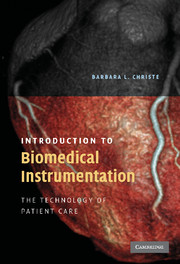Book contents
- Frontmatter
- Contents
- Preface
- INTRODUCTION TO BIOMEDICAL INSTRUMENTATION
- 1 BMET as a career
- 2 Patient safety
- 3 In the workplace
- 4 Electrodes, sensors, signals, and noise
- 5 The heart
- 6 Cardiac assist devices
- 7 Blood pressure
- 8 Respiration and respiratory therapy
- 9 The brain and its activity
- 10 The intensive care unit
- 11 The operating room
- 12 Imaging
- 13 Clinical laboratory equipment
- 14 Intravenous pumps and other pumps
- 15 Miscellaneous devices and topics
- Index
8 - Respiration and respiratory therapy
- Frontmatter
- Contents
- Preface
- INTRODUCTION TO BIOMEDICAL INSTRUMENTATION
- 1 BMET as a career
- 2 Patient safety
- 3 In the workplace
- 4 Electrodes, sensors, signals, and noise
- 5 The heart
- 6 Cardiac assist devices
- 7 Blood pressure
- 8 Respiration and respiratory therapy
- 9 The brain and its activity
- 10 The intensive care unit
- 11 The operating room
- 12 Imaging
- 13 Clinical laboratory equipment
- 14 Intravenous pumps and other pumps
- 15 Miscellaneous devices and topics
- Index
Summary
LEARNING OBJECTIVES
1 list and describe the components of inspired and expired air
2 list and describe the important lung volumes
3 describe a spirometer
4 describe impedance plethysmography
5 describe apnea
6 describe capnography
7 list and describe the functions and settings of a ventilator
8 describe and characterize high-frequency ventilation
9 describe the method of connection between patients and the ventilator
10 describe nebulizer, oxygen tent, and humidifier
Introduction
The focus of this chapter is external human respiration. Moving air in and out of the lungs is external respiration and the focus of technological interventions. The exchange of gases in the alveoli is part of internal respiration, but it is not essential to this chapter. Here are some important facts related to respiration:
Make-up of air: 79% nitrogen, 20.96% oxygen, and 0.04% carbon dioxide
Make-up of expired air: 79% nitrogen (unaffected by respiration), 17% oxygen, and 4% carbon dioxide (human's waste product)
It is important to know that the exchange of gas in the lungs occurs in the alveoli.
Respiration measurements
Volumes of gases that fill the lungs during different moments in respiration are important to BMETs since many machines try to fill those volumes. Amounts vary by the age, height, gender, and physical condition of a patient.
Tidal volume: Breathing volume is about 500 milliliters (mL) for an average adult male. This is the main value of importance. Figure 8.1 shows a sine wave that illustrates the action of breathing in and out.
Information
- Type
- Chapter
- Information
- Introduction to Biomedical InstrumentationThe Technology of Patient Care, pp. 113 - 126Publisher: Cambridge University PressPrint publication year: 2009
